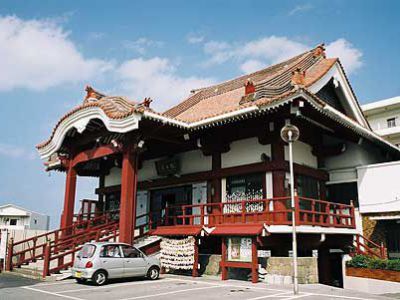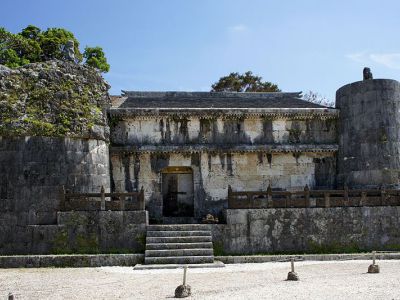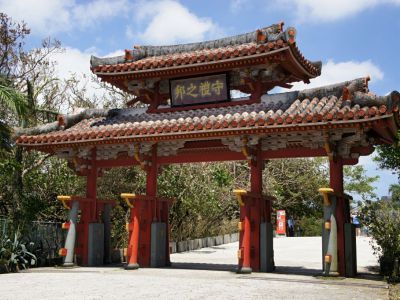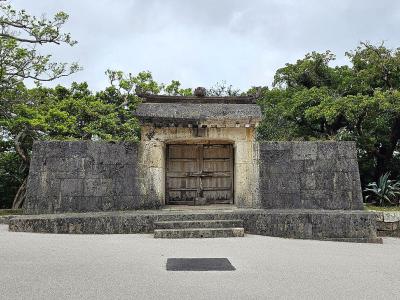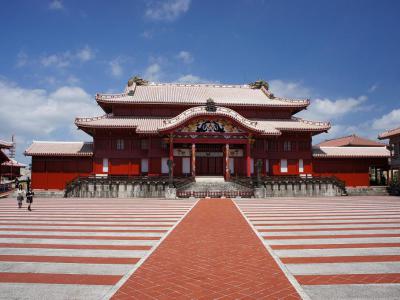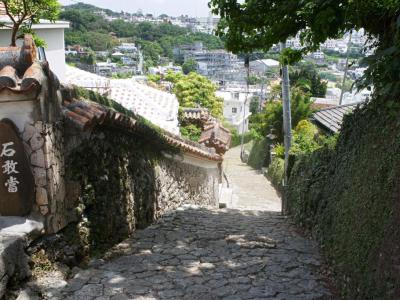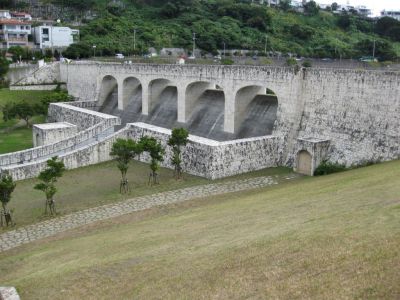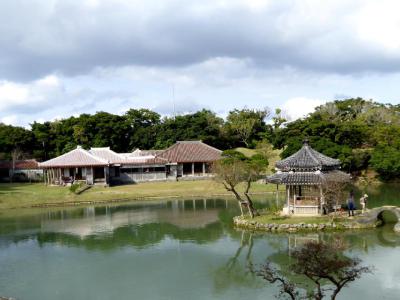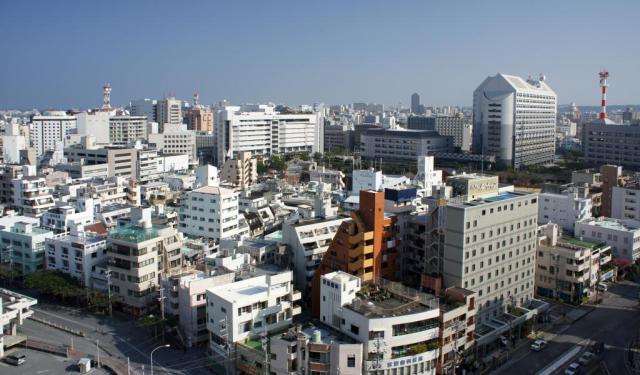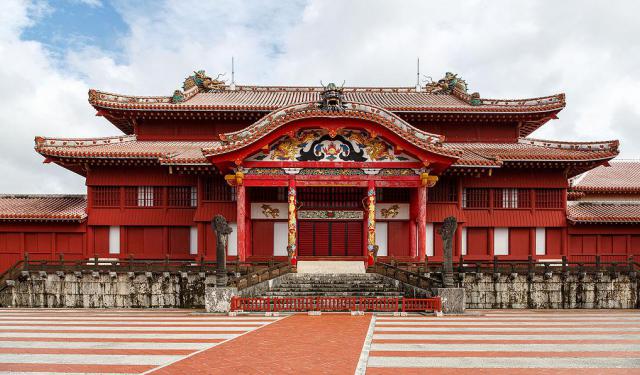
Shuri District Walking Tour (Self Guided), Naha
Shuri is a district of the city of Naha. It was formerly a separate city in and of itself, and the royal capital of the Ryūkyū Kingdom. A number of famous historical sites are located in Shuri, including Shuri Castle, the Shureimon gate, Sunuhyan-utaki (a sacred space of the native Ryukyuan religion), and royal mausoleum Tamaudun, all of which are designated World Heritage Sites by UNESCO.
Originally established as a castle town surrounding the royal palace, Shuri ceased to be the capital when the kingdom was abolished and incorporated into Japan as Okinawa prefecture. In 1954, it was merged again into Naha. ***PH***
Originally established as a castle town surrounding the royal palace, Shuri ceased to be the capital when the kingdom was abolished and incorporated into Japan as Okinawa prefecture. In 1954, it was merged again into Naha. ***PH***
How it works: Download the app "GPSmyCity: Walks in 1K+ Cities" from Apple App Store or Google Play Store to your mobile phone or tablet. The app turns your mobile device into a personal tour guide and its built-in GPS navigation functions guide you from one tour stop to next. The app works offline, so no data plan is needed when traveling abroad.
Shuri District Walking Tour Map
Guide Name: Shuri District Walking Tour
Guide Location: Japan » Naha (See other walking tours in Naha)
Guide Type: Self-guided Walking Tour (Sightseeing)
# of Attractions: 8
Tour Duration: 2 Hour(s)
Travel Distance: 3.8 Km or 2.4 Miles
Author: DanaU
Sight(s) Featured in This Guide:
Guide Location: Japan » Naha (See other walking tours in Naha)
Guide Type: Self-guided Walking Tour (Sightseeing)
# of Attractions: 8
Tour Duration: 2 Hour(s)
Travel Distance: 3.8 Km or 2.4 Miles
Author: DanaU
Sight(s) Featured in This Guide:
- Shuri Kannon-do
- Tamaudun Mausoleum
- Shureimon Gate
- Sonohyan-utaki Stone Gate and Grove
- Shuri Castle and Park
- Kinjo-cho Stone Path
- Kinjo Dam
- Shikinaen Royal Residence and Garden
1) Shuri Kannon-do
Established in 1616, Shuri Kannon-do has served as a site of prayer and contemplation for centuries. Situated near the majestic Shuri Castle, Shuri Kannon-do boasts a traditional Japanese architectural style, characterized by pristine white walls and a striking red roof—a visual testament to the enduring elegance of Japanese craftsmanship. Over the years, Shuri Kannon-do has been a place of solace for travelers embarking on journeys to mainland Japan, seeking blessings for safe passage and auspicious travels.
Beyond its architectural beauty, Shuri Kannon-do holds within its sacred grounds a collection of revered Buddha statues, each associated with the ancient custom of "Shuri 12 Zodiac Meguri." This pilgrimage tradition, deeply ingrained in the cultural fabric of Shuri, invites visitors to pay homage to the Buddha corresponding to their zodiac sign. Shuri Kannon-do is home to Buddha statues that oversee the zodiacs of Rat, Ox, Tiger, Dragon, Snake, and Horse, embodying the spiritual guardianship and guidance believed to shape the lives of devotees.
Although the temple endured severe bombing during conflict, it was fortunate to preserve precious relics, including a Gautama Buddha statue dating back more than 400 years. Additionally, the venerable "Elder Tree," a banyan tree over 120 years old, stands as a living testament to endurance and survival, revered as an object of worship in front of the main hall.
Beyond its architectural beauty, Shuri Kannon-do holds within its sacred grounds a collection of revered Buddha statues, each associated with the ancient custom of "Shuri 12 Zodiac Meguri." This pilgrimage tradition, deeply ingrained in the cultural fabric of Shuri, invites visitors to pay homage to the Buddha corresponding to their zodiac sign. Shuri Kannon-do is home to Buddha statues that oversee the zodiacs of Rat, Ox, Tiger, Dragon, Snake, and Horse, embodying the spiritual guardianship and guidance believed to shape the lives of devotees.
Although the temple endured severe bombing during conflict, it was fortunate to preserve precious relics, including a Gautama Buddha statue dating back more than 400 years. Additionally, the venerable "Elder Tree," a banyan tree over 120 years old, stands as a living testament to endurance and survival, revered as an object of worship in front of the main hall.
2) Tamaudun Mausoleum
The Tamaudun Mausoleum, nestled conveniently near the iconic Shuri Castle, stands as a testament to the regal legacy of Hana. Constructed at the dawn of the 16th century, this revered shrine served as the final resting place for the royal family of the Ryukyu Kingdom. Despite enduring significant damage during the tumultuous events of World War II, the mausoleum underwent meticulous restoration efforts and has since been recognized as a UNESCO World Heritage Site, preserving its historical and cultural significance for generations to come.
Stepping into the Tamaudun Mausoleum is to enter a realm steeped in ancient tradition and reverence. Its architectural design, characterized by two main rooms—one for kings and queens, and the other for princes and princesses—exudes a solemn grandeur befitting the royal lineage it honors. The central hall served as a sacred space for solemn ceremonies marking the departure of departed royalty, offering visitors a glimpse into the solemn rituals and customs that shaped the kingdom's spiritual heritage.
To explore the hallowed halls of the Tamaudun Mausoleum and delve deeper into its storied past, visitors are required to pay a modest admission fee of 300 yen. Beyond the solemn chambers of the mausoleum, an enriching experience awaits in the museum nestled within its basement. Here, visitors can immerse themselves in the history and legacy of the mausoleum, perusing a collection of photographs capturing its splendor before the ravages of war.
Stepping into the Tamaudun Mausoleum is to enter a realm steeped in ancient tradition and reverence. Its architectural design, characterized by two main rooms—one for kings and queens, and the other for princes and princesses—exudes a solemn grandeur befitting the royal lineage it honors. The central hall served as a sacred space for solemn ceremonies marking the departure of departed royalty, offering visitors a glimpse into the solemn rituals and customs that shaped the kingdom's spiritual heritage.
To explore the hallowed halls of the Tamaudun Mausoleum and delve deeper into its storied past, visitors are required to pay a modest admission fee of 300 yen. Beyond the solemn chambers of the mausoleum, an enriching experience awaits in the museum nestled within its basement. Here, visitors can immerse themselves in the history and legacy of the mausoleum, perusing a collection of photographs capturing its splendor before the ravages of war.
3) Shureimon Gate
As the second of Shuri Castle's main gates, Shureimon Gate is steeped in history, dating back to its construction in the 16th century. Reflecting a blend of Chinese architectural influence and indigenous religious traditions, the gate's design embodies a harmonious fusion of cultural elements.
One of the most striking features of Shureimon Gate is the four Chinese characters adorning its façade: Shu, rei, no, and kuni, meaning 'Land of Propriety.' While these characters were added to the gate long after its original construction, they serve as a poignant reminder of the gate's cultural significance and historical legacy. The gate's structure, reminiscent of traditional Chinese three-bay turret gates, is crowned by a distinctive red-tiled hip roof, evoking a sense of grandeur and majesty.
Despite enduring destruction during the ravages of the Second World War, Shureimon Gate rose from the ashes, thanks to local campaigns and community support in the 1950s and 60s. It stands as a testament to the resilience and determination of the Okinawan people to preserve their cultural heritage in the face of adversity. In fact, Shureimon Gate was the first part of Shuri Castle to be reconstructed, paving the way for subsequent efforts to restore this iconic landmark to its former glory.
The significance of Shureimon Gate extends beyond its architectural beauty and historical importance. Its image graced the 2000 yen note issued in 2000 to commemorate the 26th G8 summit held in Okinawa, further cementing its status as a symbol of Okinawa's cultural identity and international significance.
One of the most striking features of Shureimon Gate is the four Chinese characters adorning its façade: Shu, rei, no, and kuni, meaning 'Land of Propriety.' While these characters were added to the gate long after its original construction, they serve as a poignant reminder of the gate's cultural significance and historical legacy. The gate's structure, reminiscent of traditional Chinese three-bay turret gates, is crowned by a distinctive red-tiled hip roof, evoking a sense of grandeur and majesty.
Despite enduring destruction during the ravages of the Second World War, Shureimon Gate rose from the ashes, thanks to local campaigns and community support in the 1950s and 60s. It stands as a testament to the resilience and determination of the Okinawan people to preserve their cultural heritage in the face of adversity. In fact, Shureimon Gate was the first part of Shuri Castle to be reconstructed, paving the way for subsequent efforts to restore this iconic landmark to its former glory.
The significance of Shureimon Gate extends beyond its architectural beauty and historical importance. Its image graced the 2000 yen note issued in 2000 to commemorate the 26th G8 summit held in Okinawa, further cementing its status as a symbol of Okinawa's cultural identity and international significance.
4) Sonohyan-utaki Stone Gate and Grove
Sonohyan-utaki stands as a sacred testament to the traditional indigenous Ryukyuan religion. Located just a few steps away from the iconic Shureimon castle gate, Sonohyan-utaki comprises a sacred grove of trees and plants that hold profound spiritual significance for the local community. Recognized as an integral component of the UNESCO World Heritage Site encompassing the Gusuku Sites and Related Properties of the Kingdom of Ryukyu, Sonohyan-utaki has also been designated an Important Cultural Property by the Japanese national government.
At the heart of Sonohyan-utaki stands a stone gate, a revered symbol of spiritual reverence and ancestral connection. While historically reserved solely for the king, the gates are now permanently closed, serving as a tangible representation of the sacred space they enclose. Visitors, both travelers and locals alike, flock to Sonohyan-utaki to offer prayers and seek solace amidst its tranquil surroundings, connecting with the ancient spiritual traditions that have endured for centuries.
Constructed in 1519 during the reign of Ryukyuan king Shō Shin, the stone gate holds deep historical and cultural significance. It served as a pivotal site for rituals and ceremonies, including prayers for safe travels before the king embarked on journeys and the initiation of the High Priestess of the native religion. Despite enduring severe damage during the 1945 Battle of Okinawa, the gate was lovingly restored in 1957, reaffirming its status as a cherished cultural treasure. Recognized for its architectural significance, the gate exhibits a unique blend of traditional Okinawan and Chinese influences, characterized by intricate details and a distinctive Japanese-style gable in the karahafu architectural style.
At the heart of Sonohyan-utaki stands a stone gate, a revered symbol of spiritual reverence and ancestral connection. While historically reserved solely for the king, the gates are now permanently closed, serving as a tangible representation of the sacred space they enclose. Visitors, both travelers and locals alike, flock to Sonohyan-utaki to offer prayers and seek solace amidst its tranquil surroundings, connecting with the ancient spiritual traditions that have endured for centuries.
Constructed in 1519 during the reign of Ryukyuan king Shō Shin, the stone gate holds deep historical and cultural significance. It served as a pivotal site for rituals and ceremonies, including prayers for safe travels before the king embarked on journeys and the initiation of the High Priestess of the native religion. Despite enduring severe damage during the 1945 Battle of Okinawa, the gate was lovingly restored in 1957, reaffirming its status as a cherished cultural treasure. Recognized for its architectural significance, the gate exhibits a unique blend of traditional Okinawan and Chinese influences, characterized by intricate details and a distinctive Japanese-style gable in the karahafu architectural style.
5) Shuri Castle and Park (must see)
Shuri Castle and Park occupies a vast expanse of five hectares, serving as a monumental symbol of Okinawa's rich history and cultural heritage. Spanning an impressive 400 meters from east to west and 200 meters from north to south, the castle's sprawling grounds offer visitors a captivating journey through centuries of Ryukyuan history and tradition.
Upon passing through its majestic castle gate, visitors are greeted by the Seiden, the largest architectural structure in the Ryukyu Kingdom. Shurijo Castle's significance transcends its physical grandeur, earning recognition as a UNESCO World Heritage site in 2000 for its remarkable blend of Japanese and Chinese architectural styles and advanced masonry techniques. Dating back to around 1427, the castle served as the royal residence for the king and his family, as well as the administrative center of the Shuri government for nearly five centuries.
Throughout its storied history, Shurijo Castle played host to a myriad of festivals and royal ceremonies, contributing to the vibrant cultural tapestry of the Ryukyuan people. The surrounding castle town flourished, attracting government officials and skilled craftsmen, nurturing a vibrant community of artists and artisans whose legacy continues to endure.
Despite facing destruction during World War II, Shurijo Castle was meticulously reconstructed in 1992, breathing new life into its ancient walls and echoing the resilience of Okinawa's cultural heritage. Today, Shurijo Castle and its surrounding historic sites, including the Stone Gate of Sonohyan Utaki, form a sprawling historical park open to the public, inviting visitors to explore the rich legacy of Ryukyuan history and culture.
Upon passing through its majestic castle gate, visitors are greeted by the Seiden, the largest architectural structure in the Ryukyu Kingdom. Shurijo Castle's significance transcends its physical grandeur, earning recognition as a UNESCO World Heritage site in 2000 for its remarkable blend of Japanese and Chinese architectural styles and advanced masonry techniques. Dating back to around 1427, the castle served as the royal residence for the king and his family, as well as the administrative center of the Shuri government for nearly five centuries.
Throughout its storied history, Shurijo Castle played host to a myriad of festivals and royal ceremonies, contributing to the vibrant cultural tapestry of the Ryukyuan people. The surrounding castle town flourished, attracting government officials and skilled craftsmen, nurturing a vibrant community of artists and artisans whose legacy continues to endure.
Despite facing destruction during World War II, Shurijo Castle was meticulously reconstructed in 1992, breathing new life into its ancient walls and echoing the resilience of Okinawa's cultural heritage. Today, Shurijo Castle and its surrounding historic sites, including the Stone Gate of Sonohyan Utaki, form a sprawling historical park open to the public, inviting visitors to explore the rich legacy of Ryukyuan history and culture.
6) Kinjo-cho Stone Path
The Kinjo-cho Stone Path was originally constructed to facilitate travel from the magnificent Shurijo Castle to the southern reaches of the island. This ancient thoroughfare offers a captivating glimpse into bygone eras, allowing modern visitors to immerse themselves in the pages of history.
Though the ravages of war have left only fragments of its original expanse intact, the Kinjo-cho Stone Path has emerged as a beloved and sought-after destination for tourists. Wandering along this venerable route, one encounters a beguiling tableau of traditional Okinawan-style houses that flank either side, imbuing the path with an undeniable charm. It's worth noting that these homes are still inhabited by local residents, so courtesy and respect are paramount when exploring this hallowed ground.
Spanning approximately 300 meters in length, the stone path's undulating surface, juxtaposed against modern paved roads, presents a modest challenge to traversers. Visitors are well-advised to don comfortable footwear to navigate this historical relic with ease and enjoyment.
Conveniently located within walking distance of the resplendent Shurijo Castle, the Kinjo-cho Stone Path offers an enticing opportunity to craft a comprehensive Okinawan historical itinerary. Here, one can seamlessly transition between the time-worn stones of the path and the grandeur of the castle, forging a connection with the past that lingers in the air, evoking the enduring spirit of Okinawa's history.
Though the ravages of war have left only fragments of its original expanse intact, the Kinjo-cho Stone Path has emerged as a beloved and sought-after destination for tourists. Wandering along this venerable route, one encounters a beguiling tableau of traditional Okinawan-style houses that flank either side, imbuing the path with an undeniable charm. It's worth noting that these homes are still inhabited by local residents, so courtesy and respect are paramount when exploring this hallowed ground.
Spanning approximately 300 meters in length, the stone path's undulating surface, juxtaposed against modern paved roads, presents a modest challenge to traversers. Visitors are well-advised to don comfortable footwear to navigate this historical relic with ease and enjoyment.
Conveniently located within walking distance of the resplendent Shurijo Castle, the Kinjo-cho Stone Path offers an enticing opportunity to craft a comprehensive Okinawan historical itinerary. Here, one can seamlessly transition between the time-worn stones of the path and the grandeur of the castle, forging a connection with the past that lingers in the air, evoking the enduring spirit of Okinawa's history.
7) Kinjo Dam
Situated just a stone's throw away from the historic Shuri Castle, the Kinjo Dam stands as a modern marvel of engineering amidst a backdrop of rich historical significance. Construction of the dam commenced in 1989 and was completed in 2000, spanning a little over a decade of meticulous planning and execution. As a concrete gravity dam, its primary purpose is to regulate flood control for the Li River, serving as a vital infrastructure asset for the local community.
While the Kinjo Dam itself may lack historical significance, its strategic location within a historical area adds to its allure. Adjacent to the revered Shikina Cemetery and intersected by the historic Shuri-Kinjocho-Stone Path, the dam's surroundings are steeped in centuries of cultural heritage. Tiered paths and stairways wind their way around the dam, offering visitors an idyllic setting for daily exercise and leisurely strolls amidst breathtaking natural scenery.
At the southeast end of the park surrounding the dam lies the Hiji River and Bridge, a testament to the region's storied past. Dating back to the 17th century, this limestone bridge serves as a poignant reminder of Okinawa's architectural legacy. The tranquil ambiance of the area, coupled with its picturesque landscapes, makes it a popular destination for nature enthusiasts and photographers seeking to capture the beauty of Kinjo Dam and its surroundings.
While the Kinjo Dam itself may lack historical significance, its strategic location within a historical area adds to its allure. Adjacent to the revered Shikina Cemetery and intersected by the historic Shuri-Kinjocho-Stone Path, the dam's surroundings are steeped in centuries of cultural heritage. Tiered paths and stairways wind their way around the dam, offering visitors an idyllic setting for daily exercise and leisurely strolls amidst breathtaking natural scenery.
At the southeast end of the park surrounding the dam lies the Hiji River and Bridge, a testament to the region's storied past. Dating back to the 17th century, this limestone bridge serves as a poignant reminder of Okinawa's architectural legacy. The tranquil ambiance of the area, coupled with its picturesque landscapes, makes it a popular destination for nature enthusiasts and photographers seeking to capture the beauty of Kinjo Dam and its surroundings.
8) Shikinaen Royal Residence and Garden (must see)
Shikinaen Royal Residence and Garden offers a serene retreat from the bustling cityscape of Naha. Spanning an expansive 42,000 square meters, much of which is enveloped by lush woodland, Shikinaen presents a rare opportunity to escape the crowds and immerse oneself in the tranquility of Okinawa's natural beauty. Unlike many tourist sites in Naha, Shikinaen cannot be reached by the Yui monorail, adding to its secluded charm.
Constructed at the end of the 18th century, Shikinaen served as a second home for the Okinawan royal family and a venue for entertaining esteemed guests. The garden, designed as a stroll garden, invites visitors to wander along winding stone paths, meandering past a guardhouse and through woodlands adorned with sub-tropical species. The garden seamlessly blends Japanese and Chinese influences, reflecting the unique cultural heritage of Okinawa.
At the heart of Shikinaen lies the royal palace, dating back to the 17th century. Offering breathtaking views of the meticulously manicured gardens, the palace features 15 rooms where visitors can immerse themselves in the opulent history of the Okinawan royal family. Stone bridges cross the tranquil pond, leading to the Rokkaku-do, a Chinese-style hexagonal pavilion, where visitors can pause to admire the picturesque scenery.
Despite facing destruction during the Battle of Okinawa in 1945, Shikinaen underwent a remarkable restoration program starting in 1975. In recognition of its cultural significance and historical importance, Shikinaen was registered as a UNESCO World Heritage Site in 2000, cementing its status as a cherished treasure of Okinawa's cultural heritage. Today, visitors to Shikinaen can stroll through its verdant landscapes, basking in the serenity of this idyllic oasis and experiencing firsthand the timeless allure of Okinawa's royal legacy.
Constructed at the end of the 18th century, Shikinaen served as a second home for the Okinawan royal family and a venue for entertaining esteemed guests. The garden, designed as a stroll garden, invites visitors to wander along winding stone paths, meandering past a guardhouse and through woodlands adorned with sub-tropical species. The garden seamlessly blends Japanese and Chinese influences, reflecting the unique cultural heritage of Okinawa.
At the heart of Shikinaen lies the royal palace, dating back to the 17th century. Offering breathtaking views of the meticulously manicured gardens, the palace features 15 rooms where visitors can immerse themselves in the opulent history of the Okinawan royal family. Stone bridges cross the tranquil pond, leading to the Rokkaku-do, a Chinese-style hexagonal pavilion, where visitors can pause to admire the picturesque scenery.
Despite facing destruction during the Battle of Okinawa in 1945, Shikinaen underwent a remarkable restoration program starting in 1975. In recognition of its cultural significance and historical importance, Shikinaen was registered as a UNESCO World Heritage Site in 2000, cementing its status as a cherished treasure of Okinawa's cultural heritage. Today, visitors to Shikinaen can stroll through its verdant landscapes, basking in the serenity of this idyllic oasis and experiencing firsthand the timeless allure of Okinawa's royal legacy.
Walking Tours in Naha, Japan
Create Your Own Walk in Naha
Creating your own self-guided walk in Naha is easy and fun. Choose the city attractions that you want to see and a walk route map will be created just for you. You can even set your hotel as the start point of the walk.
Naha Introduction Walking Tour
Naha, the capital of Okinawa, although small a city, does contain a plethora of historic attractions. If you decide to visit Naha, make sure to explore the Shikina-en Garden, Tamaudun Mausoleum, but most importantly, the Shuri Castle, a restored royal residence of the Ryukyu Kingdom, flourished throughout the 15th-19th centuries and recognized as the birthplace of Okinawa karate. Take this... view more
Tour Duration: 2 Hour(s)
Travel Distance: 3.7 Km or 2.3 Miles
Tour Duration: 2 Hour(s)
Travel Distance: 3.7 Km or 2.3 Miles
The Most Popular Cities
/ view all
